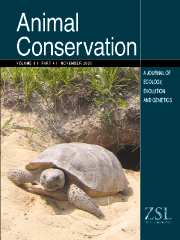Crossref Citations
This article has been cited by the following publications. This list is generated based on data provided by
Crossref.
Jones, Carl G.
2002.
Handbook of Ecological Restoration.
p.
355.
Weaver, David
2002.
Asian ecotourism: Patterns and themes.
Tourism Geographies,
Vol. 4,
Issue. 2,
p.
153.
Milazzo, M.
Badalamenti, F.
Vega Fern�ndez, T.
and
Chemello, R.
2005.
Effects of fish feeding by snorkellers on the density and size distribution of fishes in a Mediterranean marine protected area.
Marine Biology,
Vol. 146,
Issue. 6,
p.
1213.
Lindsey, Peter A.
Alexander, Robert R.
du Toit, Johan T.
and
Mills, M.G.L.
2005.
The potential contribution of ecotourism to African wild dog Lycaon pictus conservation in South Africa.
Biological Conservation,
Vol. 123,
Issue. 3,
p.
339.
Lemelin, R. Harvey
2006.
The Gawk, The Glance, and The Gaze: Ocular Consumption and Polar Bear Tourism in Churchill, Manitoba, Canada.
Current Issues in Tourism,
Vol. 9,
Issue. 6,
p.
516.
Cihar, Martin
and
Stankova, Jindriska
2006.
Attitudes of stakeholders towards the Podyji/Thaya River Basin National Park in the Czech Republic.
Journal of Environmental Management,
Vol. 81,
Issue. 3,
p.
273.
Newsome, David
and
Rodger, Kate
2008.
Too close for comfort.
p.
255.
Guttridge, Tristan L
Myrberg, Arthur A
Porcher, Ila F
Sims, David W
and
Krause, Jens
2009.
The role of learning in shark behaviour.
Fish and Fisheries,
Vol. 10,
Issue. 4,
p.
450.
Maljković, Aleksandra
and
Côté, Isabelle M.
2011.
Effects of tourism-related provisioning on the trophic signatures and movement patterns of an apex predator, the Caribbean reef shark.
Biological Conservation,
Vol. 144,
Issue. 2,
p.
859.
Sitorus, Tamen
2011.
Island Futures.
p.
99.
Jessop, Tim S.
Smissen, Peter
Scheelings, Franciscus
Dempster, Tim
and
Hayward, Matt
2012.
Demographic and Phenotypic Effects of Human Mediated Trophic Subsidy on a Large Australian Lizard (Varanus varius): Meal Ticket or Last Supper?.
PLoS ONE,
Vol. 7,
Issue. 4,
p.
e34069.
Dubois, Sara
and
Fraser, David
2013.
A Framework to Evaluate Wildlife Feeding in Research, Wildlife Management, Tourism and Recreation.
Animals,
Vol. 3,
Issue. 4,
p.
978.
ENDO, Hideki
2013.
The Difficulties of Conservation of the Komodo Monitors Related to Tourism and Local Economics in the Eastern Region of Indonesia.
Japanese Journal of Zoo and Wildlife Medicine,
Vol. 18,
Issue. 1,
p.
29.
Knapp, C. R.
Hines, K. N.
Zachariah, T. T.
Perez-Heydrich, C.
Iverson, J. B.
Buckner, S. D.
Halach, S. C.
Lattin, C. R.
and
Romero, L. M.
2013.
Physiological effects of tourism and associated food provisioning in an endangered iguana.
Conservation Physiology,
Vol. 1,
Issue. 1,
p.
cot032.
Selva, Nuria
Berezowska-Cnota, Teresa
Elguero-Claramunt, Isabel
and
Festa-Bianchet, Marco
2014.
Unforeseen Effects of Supplementary Feeding: Ungulate Baiting Sites as Hotspots for Ground-Nest Predation.
PLoS ONE,
Vol. 9,
Issue. 3,
p.
e90740.
Gallagher, Austin J.
Vianna, Gabriel M.S.
Papastamatiou, Yannis P.
Macdonald, Catherine
Guttridge, Tristan L.
and
Hammerschlag, Neil
2015.
Biological effects, conservation potential, and research priorities of shark diving tourism.
Biological Conservation,
Vol. 184,
Issue. ,
p.
365.
Macdonald, Catherine
Gallagher, Austin J.
Barnett, Adam
Brunnschweiler, Juerg
Shiffman, David S.
and
Hammerschlag, Neil
2017.
Conservation potential of apex predator tourism.
Biological Conservation,
Vol. 215,
Issue. ,
p.
132.
Pruitt, Jonathan N.
Howell, Kimberly A.
Gladney, Shaniqua J.
Yang, Yusan
Lichtenstein, James L. L.
Spicer, Michelle Elise
Echeverri, Sebastian A.
and
Pinter-Wollman, Noa
2017.
Behavioral Hypervolumes of Predator Groups and Predator-Predator Interactions Shape Prey Survival Rates and Selection on Prey Behavior.
The American Naturalist,
Vol. 189,
Issue. 3,
p.
254.
Bach, Lydia
and
Burton, Michael
2017.
Proximity and animal welfare in the context of tourist interactions with habituated dolphins.
Journal of Sustainable Tourism,
Vol. 25,
Issue. 2,
p.
181.
Ardiantiono
Jessop, Tim S.
Purwandana, Deni
Ciofi, Claudio
Jeri Imansyah, M.
Panggur, Maria Rosdalima
and
Ariefiandy, Achmad
2018.
Effects of human activities on Komodo dragons in Komodo National Park.
Biodiversity and Conservation,
Vol. 27,
Issue. 13,
p.
3329.


